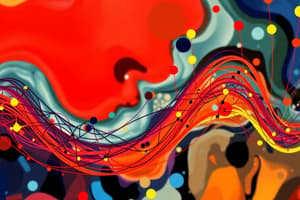Podcast
Questions and Answers
What is the purpose of Recurrent Neural Networks (RNN)?
What is the purpose of Recurrent Neural Networks (RNN)?
- To classify text documents
- To recognize patterns and predict sequential data (correct)
- To perform image recognition tasks
- To generate random numbers
What is the key feature that distinguishes RNN from other neural networks?
What is the key feature that distinguishes RNN from other neural networks?
- It has a larger number of layers
- It uses unsupervised learning
- It has a higher learning rate
- It can remember historical decisions by considering sequential characteristics (correct)
What is the concept of unfolding computational graphs in the context of RNN?
What is the concept of unfolding computational graphs in the context of RNN?
- It involves randomizing the connections between neurons
- It focuses on reducing the number of layers in a neural network
- It aims to increase the computational complexity of the network
- It involves mapping inputs into a recursive and repeated structure (correct)
What is the purpose of sharing parameters across the outcome of unfolding in RNN?
What is the purpose of sharing parameters across the outcome of unfolding in RNN?
How is the structure of a dynamical system formalized in the context of RNN?
How is the structure of a dynamical system formalized in the context of RNN?
Flashcards are hidden until you start studying
Study Notes
Recurrent Neural Networks (RNNs)
- Purpose: RNNs are designed to handle sequential data, allowing them to model temporal relationships in data, and make predictions based on sequential input data.
Distinguishing Feature of RNNs
- Key feature: RNNs have a feedback loop, allowing information from previous time steps to influence the current step, distinguishing them from other neural networks.
Unfolding Computational Graphs in RNNs
- Unfolding: Computational graphs in RNNs are unfolded, meaning they are expanded to show the recurrent connections, allowing the network to process sequential data.
Parameter Sharing in RNNs
- Purpose of parameter sharing: Parameters are shared across the outcome of unfolding to ensure that the same learned patterns are applied across all time steps, enabling the network to model temporal relationships.
Dynamical Systems in RNNs
- Formalizing dynamical systems: In RNNs, the structure of a dynamical system is formalized using a set of fixed, recursive equations that describe the evolution of the system over time.
Studying That Suits You
Use AI to generate personalized quizzes and flashcards to suit your learning preferences.



